Maximize the potential of modern security solutions with our all-inclusive guide on electronic locks. I’ve personally experienced the convenience and peace of mind offered by keypad locks, which utilize numerical codes to eliminate the need for physical keys. Imagine the ease of controlling home access via smartphone apps with smart locks, or the robust protection of biometric locks utilizing fingerprints and facial recognition. Card reader locks, perfect for commercial settings, offer secure and convenient access using RFID technology. To conclude, Wi-Fi enabled locks integrate seamlessly with smart home systems for real-time control and notifications. Discover more about these cutting-edge technologies.
Introduction
In today’s rapidly evolving technological landscape, electronic locks frequently serve as a cornerstone of modern security systems, offering unparalleled convenience and advanced functionality. My own journey began when I integrated a smart lock into my home, marveling at the seamless blend of security and ease it provided. These locks, encompassing smart, biometric, and keypad varieties, transform entryways into fortified yet accessible portals. Though their initial investment can be substantial, the long-term benefits far outweigh the costs. A critical aspect to ponder is their dependency on power or batteries, which, if neglected, can become a vulnerability. However, with proper security measures, electronic locks become an indispensable part of a sophisticated, user-friendly home security framework.
Keypad Locks
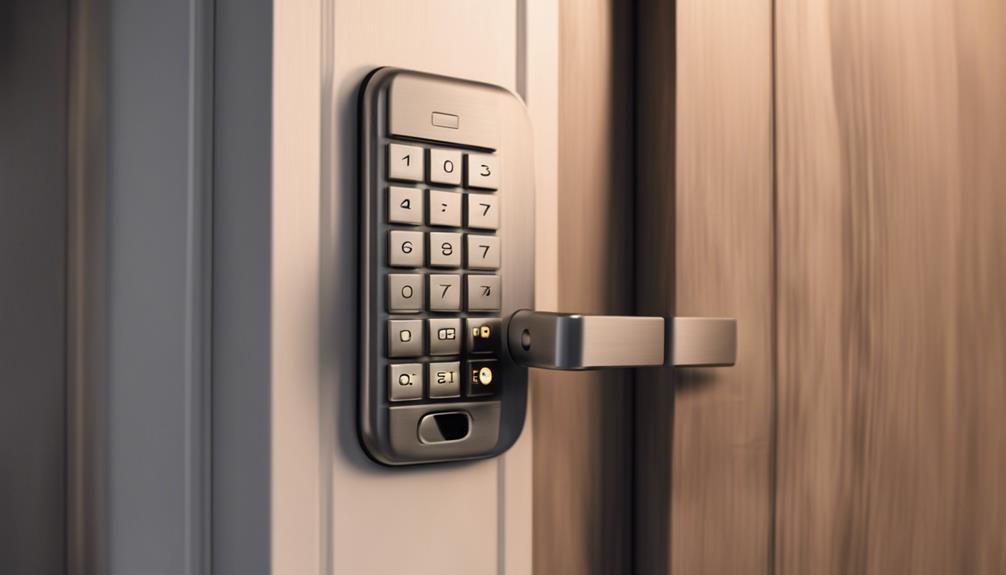
Keypad locks represent a remarkable fusion of convenience and security, utilizing numerical keypads for access and eliminating the need for physical keys. They can be programmed with multiple codes, allowing different users to have individualized entry, and even offer advanced features like temporary or one-time use codes. In my experience, installing a keypad lock in both residential and commercial properties has greatly enhanced ease of access and bolstered security measures.
How Keypad Locks Work
Imagine the convenience of effortlessly accessing your door by simply entering a code on a numeric keypad, a feature that keypad locks bring to modern security systems. These locks eliminate the need for physical keys, offering a seamless entry experience. Users can easily program and change access codes, enhancing security. This feature was particularly helpful when I needed to grant temporary access to a visiting family member. Some keypad locks even integrate with smart home systems, adding layers of functionality such as remote access and built-in alarms. They operate on batteries, so a quick check and replacement guarantee they remain reliable. Truly, keypad locks blend practicality with advanced technology, making home access both secure and straightforward.
Benefits of Keypad Locks
Accessing a world of convenience and enhanced security, numerical code-based keypad locks bring a multitude of benefits to modern homes and shared spaces. These locks eliminate the need for physical keys, a feature I found particularly liberating when I no longer had to fumble through my bag in the dark. The ease of changing access codes provides a seamless solution for households and rental properties, ensuring security remains tight without the hassle of rekeying. Additionally, the ability to generate temporary access codes for guests or service providers offers an added layer of flexibility. With keypad locks, the risk of lost or stolen keys vanishes, making us feel safer and more in control of our living spaces.
Best Uses for Keypad Locks
For anyone looking to revolutionize their security setup, keypad locks provide an ideal solution for various environments, including homes, offices, and rental properties. I recall the relief my friend felt when she no longer needed to juggle keys for her vacation rental. With keypad locks, she could simply assign unique codes to each guest, ensuring easy access control and enhanced security. These locks are perfect for offices where multiple employees require secure entry or for homes integrated with smart systems, allowing remote access and monitoring. Battery-operated, they minimize installation hassles, and their ability to store multiple user codes offers unparalleled flexibility. Truly, keypad locks blend convenience with cutting-edge security, making them indispensable in today’s fast-paced world.
Smart Locks
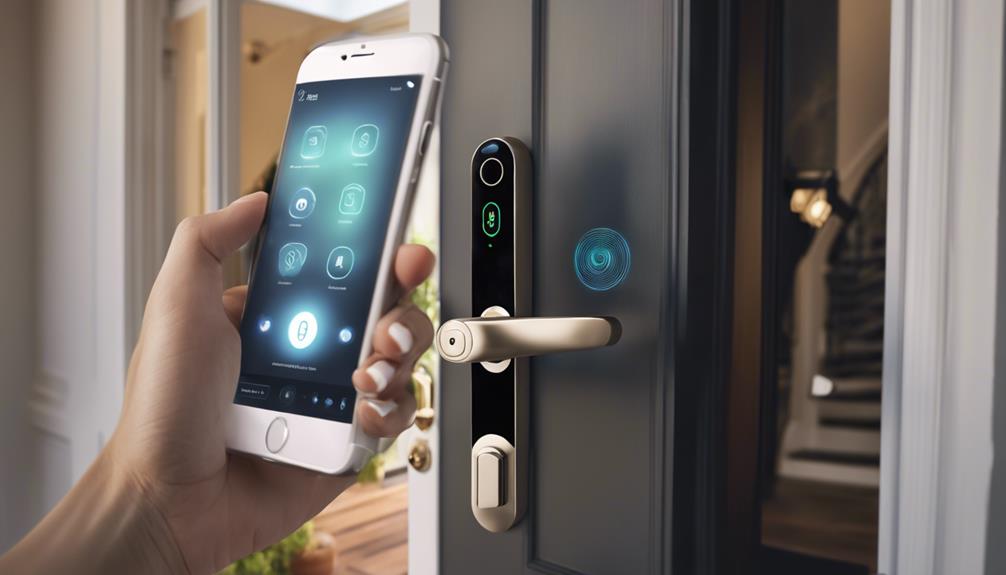
Smart locks have revolutionized home security, offering features like remote control via smartphone apps and integration with home automation systems. I recall the first time I installed a smart lock at my home, marveling at the convenience of granting temporary access codes to guests right from my phone. These locks often require straightforward installation and setup, providing enhanced security through biometric options like fingerprint or facial recognition.
Features of Smart Locks
Imagine a world where your smartphone doubles as a key, granting you seamless, secure entry to your home or business with just a tap or voice command. Smart locks make this vision a reality, offering electronic mechanisms like keypads or Bluetooth for keyless entry. I remember the first time I accessed my door from miles away using a smartphone app; it felt like magic. These locks integrate effortlessly with smart home systems, letting you control and monitor access remotely. Some even employ biometric technology, recognizing fingerprints or facial features for added security. However, they rely on power sources such as batteries or electrical wiring, ensuring they function smoothly. With smart locks, convenience and security are quite literally at your fingertips.
Installation and Setup
As the benefits of smart locks become increasingly clear, the next step involves understanding the straightforward process of installation and setup. Most smart locks fit standard doors, requiring just basic tools like a screwdriver or drill. My first smart lock installation was a breeze, thanks to the detailed step-by-step instructions provided. Connecting the lock to my Wi-Fi network was simple and enabled seamless remote access. Many smart locks also integrate effortlessly with existing smart home systems, enhancing control. Video tutorials are often available, making the setup process even smoother. Embracing this modern convenience not only enhances security but also offers a gratifying DIY experience that anyone can achieve with a bit of patience and enthusiasm.
Advantages of Smart Locks
Embracing the innovative functionality of smart locks offers unparalleled convenience, transforming the traditional approach to home security into a seamless and sophisticated experience. Imagine arriving home, arms full of groceries, and simply accessing your door with your smartphone. Smart locks eliminate fumbling for keys, allowing keyless entry via a smartphone, keypad, or remote control. They enable you to grant access to guests or service providers remotely, a feature I’ve found invaluable when hosting out-of-town visitors. Integrated with home automation systems, these locks respond to voice commands or mobile apps, enhancing ease of use. Security features like tamper alerts, activity logs, and temporary access codes not only enhance protection but also bring peace of mind. This technology seamlessly integrates into a comprehensive smart home security system, ensuring your sanctuary remains secure.
Biometric Locks
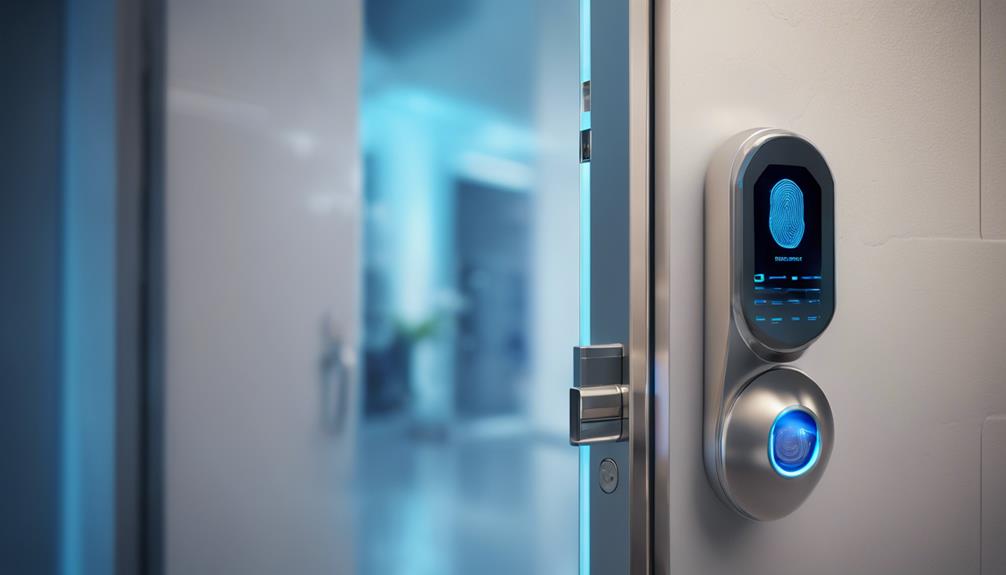
Biometric locks represent a fascinating leap in security technology by utilizing unique biological characteristics, such as fingerprints or retinal scans, to grant access. I remember the first time I used a fingerprint lock—it was incredible to see how seamlessly it blended high security with sheer convenience, eliminating the need for cumbersome keys. These locks not only offer robust protection but also integrate smoothly with smart home systems, making them a versatile choice for modern security needs.
How Biometric Locks Function
Fingerprint scanners, retinal readers, and facial recognition systems exemplify the sophisticated mechanisms at the heart of biometric locks, utilizing unique biological attributes to guarantee secure access control. These devices meticulously analyze individual characteristics, ensuring only authorized users gain entry. Imagine the convenience: no more fumbling for keys or memorizing codes. My own experience with a biometric lock was transformative—just a quick fingerprint scan granted seamless access. These locks can store multiple user profiles, making it incredibly practical for families or workplaces. The rapid advancements in biometric technology mean faster, more accurate recognition, boosting both security and user satisfaction. Embracing such innovation, we step into a future where security meets convenience in the most personal way.
Security Benefits
Leveraging unique biological traits, biometric locks offer unparalleled security, making it nearly impossible for unauthorized individuals to gain access. My personal experience with biometric locks at our family cabin has been transformational. We no longer worry about losing keys during our hiking trips. These locks utilize fingerprints or retinal scans, which are incredibly difficult to duplicate or hack, providing peace of mind that traditional keys or keypads simply can’t match. Additionally, their ability to store multiple user profiles means everyone in the family has personalized access. This convenience and the high level of security make biometric locks an excellent choice for anyone seeking to enhance the safety of their home or business.
Applications for Biometric Locks
Incorporating biometric locks into various environments has revolutionized security measures, offering unparalleled protection and convenience across a range of applications. As a seasoned locksmith, I’ve seen firsthand the transformative impact of these advanced systems. Biometric locks, utilizing unique physical characteristics like fingerprints and retinal scans, are nearly impossible to duplicate or hack. In high-security settings such as government facilities and corporate offices, these locks guarantee that only authorized personnel gain entry. On a more personal note, integrating biometric locks with smart home systems provides an effortless blend of heightened security and convenience. Imagine the peace of mind knowing your home is safeguarded without the hassle of keys or codes. This technology truly elevates the security experience.
Card Reader Locks
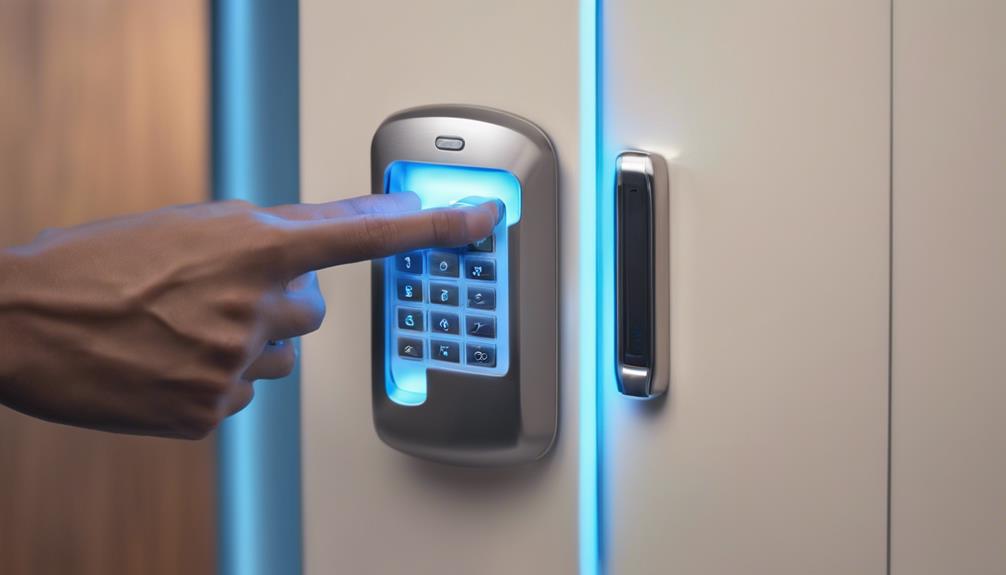
Card reader locks utilize RFID technology to provide secure and convenient access by simply swiping or tapping a programmed card, a feature that I first encountered during a business trip and found incredibly efficient. These locks are particularly advantageous for commercial settings like hotels and office spaces, where they can be easily programmed to restrict access to authorized personnel. Additionally, their integration with access control systems enhances security, making them an ideal solution for both large-scale operations and home security.
Working Mechanism of Card Reader Locks
Utilizing advanced electronic technology, card reader locks operate by reading encoded information from a user’s card to authenticate and grant access, ensuring a robust security solution for various settings. In my experience, the convenience of these locks is unparalleled; simply swiping or inserting the card provides swift entry. Often used in hotels and offices, these locks can be programmed to allow or restrict access to specific areas at designated times, adding a layer of tailored security. Imagine walking into your office, a simple card swipe granting you seamless access to restricted areas. This efficient management of access control not only enhances security but also simplifies the process, making it an indispensable tool in modern security systems.
Advantages for Home Security
For homeowners seeking a blend of security and convenience, card reader locks offer a sophisticated solution that effectively guarantees the need for traditional keys. Imagine the ease of simply tapping a card to gain access to your sanctuary, without fumbling for keys. The added security of requiring a valid access card guarantees only authorized individuals can enter, providing peace of mind. These locks can be effortlessly programmed to grant or revoke access, adapting to your changing needs. My sister recently installed one and loves how seamlessly it integrates with her home security system, allowing for real-time monitoring. The convenience and enhanced control make card reader locks a compelling choice for modern home security, combining advanced technology with user-friendly functionality.
Ideal Locations for Card Reader Locks
Many high-security environments, such as government buildings, corporate offices, and data centers, find that implementing card reader locks greatly enhances their access control measures. Utilizing RFID technology, these locks read authorized access cards, providing a seamless yet secure entry method. When I first encountered these in a data center, I was fascinated by their ability to track access logs meticulously. This feature not only monitors who enters and exits but also fortifies security by limiting access to authorized personnel. The unique codes on access cards guarantee that only credentialed individuals gain entry, reducing unauthorized access risks to a large extent. For anyone looking to bolster security in sensitive areas, card reader locks are an invaluable asset.
Bluetooth Enabled Locks
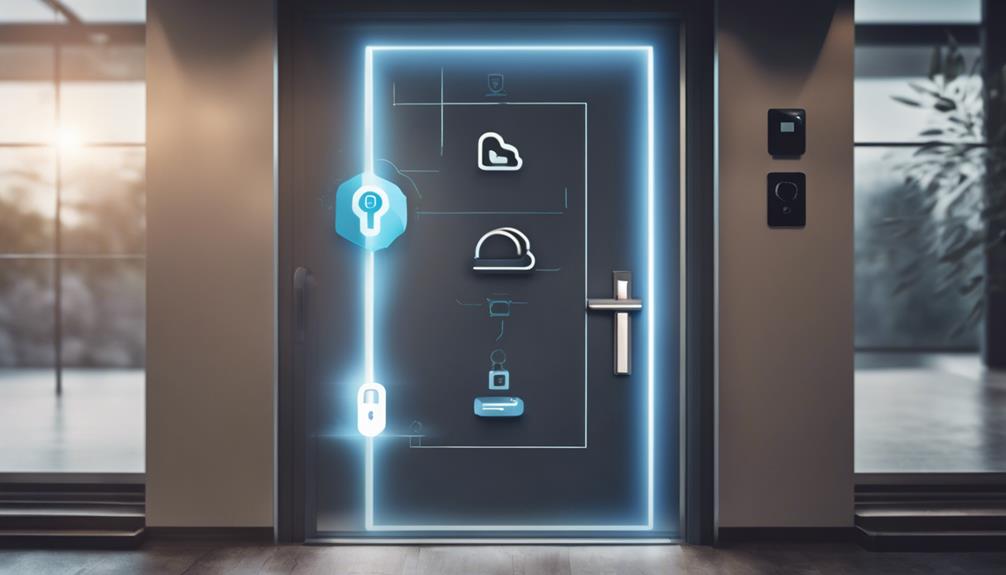
Bluetooth enabled locks epitomize the seamless integration of technology and security, allowing users to open doors with a simple tap on their smartphone. From personal experience, the convenience of managing access remotely, whether granting temporary entry to guests or monitoring activity logs, has been a game-changer for home security. These locks are particularly well-suited for smart homes, offering both enhanced security features and unparalleled ease of use.
Functionality of Bluetooth Locks
Accessing new levels of convenience, Bluetooth-enabled locks leverage wireless technology to seamlessly connect with smartphones, offering a modern solution to keyless entry. Imagine returning home with your hands full, yet effortlessly open your door with a quick tap on your phone. These innovative locks not only eliminate the need for physical keys but also grant features like remote access, activity logs, and temporary access codes for guests. Integrating seamlessly with smart home systems, Bluetooth locks allow you to control and monitor your home from anywhere. My personal experience with remote access has been a game-changer, providing peace of mind when I’m away. With encryption and two-factor authentication, these locks guarantee robust security alongside unparalleled convenience.
Security and Convenience
Incorporating both cutting-edge technology and user-friendly features, Bluetooth-enabled locks epitomize the perfect blend of security and convenience for modern homes. Imagine arriving home with your hands full and effortlessly opening your door with just a tap on your smartphone. This seamless experience is complemented by the ability to integrate these locks with smart home systems, allowing you to monitor and control access from anywhere. The added security features, such as activity logs and temporary access codes, guarantee you always know who is entering your space. However, maintaining a stable Bluetooth connection and keeping an eye on battery levels are essential for uninterrupted performance. With Bluetooth locks, convenience meets peace of mind, making them an ideal choice for contemporary living.
Best Applications
For homeowners seeking the ultimate in convenience and security, integrating smartphone-controlled locks into their daily routine offers an unparalleled blend of functionality and peace of mind. Imagine effortlessly opening your door as you approach, no more fumbling for keys. Bluetooth enabled locks are perfect for Airbnb hosts or rental property owners, allowing remote access granting. The secure, encrypted connection guarantees your property remains protected. Personalized notifications when the lock is accessed keep you in the loop, enhancing control over entry. Installation is straightforward, catering to tech-savvy individuals who value simplicity. My friend, an Airbnb host, swears by the convenience these locks provide, transforming property management into a seamless experience.
Wi-Fi Enabled Locks
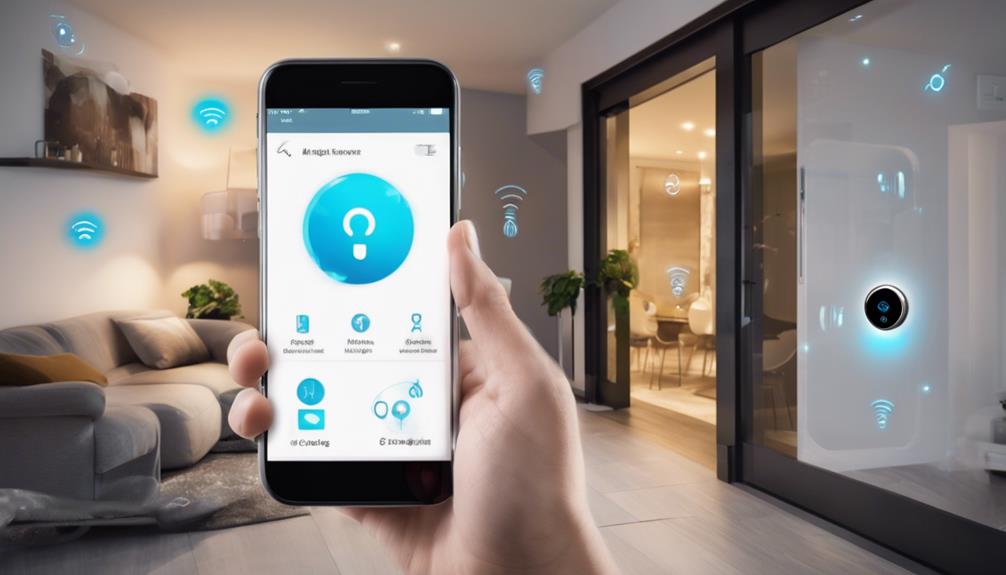
Wi-Fi enabled locks revolutionize home security by utilizing wireless technology to provide remote access and control via smartphones or computers. Their seamless integration with smart home systems allows users to manage access schedules, receive real-time notifications, and monitor lock status from virtually anywhere. Personally, the convenience of granting temporary access codes to guests has greatly enhanced my home’s security and flexibility, making it a top choice for modern living.
How Wi-Fi Locks Operate
Harnessing the power of wireless internet, Wi-Fi enabled locks revolutionize home security by allowing users to control their locks remotely through smartphones or computers. I recall the first time I effortlessly opened my front door while still at the office, marveling at the convenience. These locks offer real-time access control, providing notifications for every entry, and granting peace of mind. Imagine being able to open your door for a visiting guest without interrupting your day. However, ensuring your Wi-Fi network is secure is essential to prevent unauthorized access. The blend of security and convenience truly transforms how we interact with our homes, making daily routines smoother and more secure.
Integration with Home Security Systems
Integrating Wi-Fi enabled locks with home security systems elevates the convenience and control homeowners have over their property, offering seamless remote access and real-time notifications for enhanced peace of mind. Imagine being able to secure and release access to your doors from anywhere, whether you’re at work, on vacation, or simply lounging in your backyard. This integration means you receive instant alerts on door activity, ensuring you’re always in the know. I recall a time when I granted temporary access to a service provider while vacationing abroad, all through my smartphone. This technology suits those with busy lifestyles or frequent travelers, blending security with the modern need for flexibility and ease.
Uses and Benefits
For homeowners seeking both enhanced security and unparalleled convenience, Wi-Fi enabled locks present a compelling solution that transforms the way we think about access control. Imagine being able to secure or open your door from anywhere—whether you’re at work or on vacation. Integrating seamlessly with smart home systems like Alexa or Google Home, these locks offer hands-free convenience. One evening, I received a notification on my smartphone as my kids arrived home safely, a small but powerful reassurance. Additionally, Wi-Fi enabled locks provide temporary access codes for guests or service providers, offering flexibility without compromising security. Even during power outages, built-in backup power guarantees your locks remain functional, underscoring their reliability.
Hybrid Locks
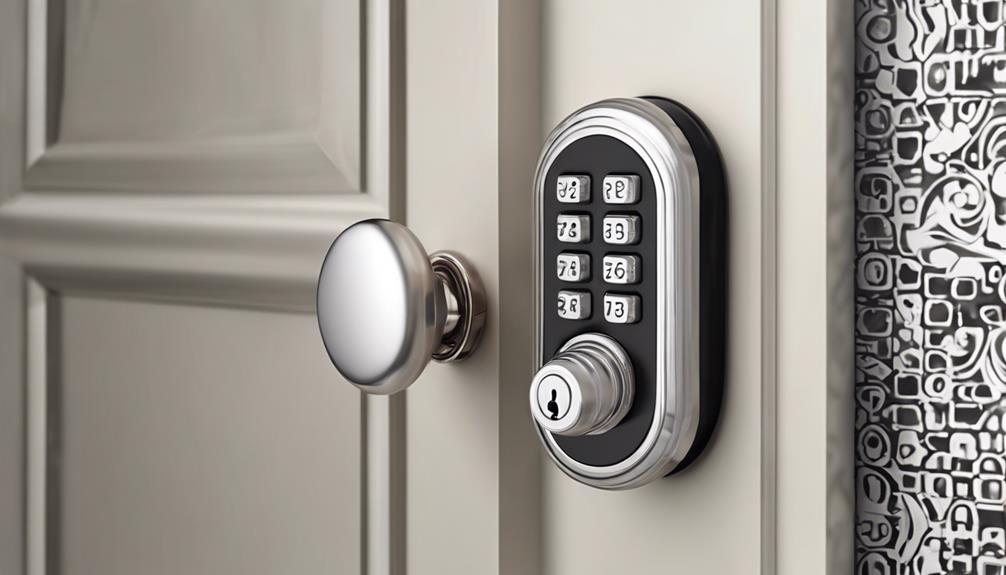
Hybrid locks represent a fascinating fusion of mechanical and electronic components, offering a versatile solution for modern security needs. I recently installed one in my own home, appreciating the seamless shift between using traditional keys and the convenience of smart devices. These locks not only enhance security but also provide much-needed flexibility for both residential and commercial applications.
What are Hybrid Locks?
Often regarded as a sophisticated solution, hybrid locks seamlessly blend the reliability of traditional mechanical components with the cutting-edge features of electronic security. I recall the first time I installed a hybrid lock in my own home; the ease of keyless entry combined with the comforting presence of a physical key felt revolutionary. These locks effortlessly integrate into smart home systems, allowing for remote access and monitoring—a boon for those of us who crave both convenience and peace of mind. Additionally, the inclusion of backup power sources, such as batteries, guarantees continuous operation during power outages. For anyone seeking a harmonious blend of tradition and modernity, hybrid locks offer the perfect balance of security and innovation.
Security and Flexibility
Having experienced firsthand the innovative blend of traditional and modern security offered by hybrid locks, I can attest to their unparalleled security and flexibility. Hybrid locks seamlessly merge the robustness of mechanical locks with the advanced features of electronic access systems. Imagine the peace of mind knowing you have a physical key as a backup while enjoying the convenience of keyless entry. Integration into smart home systems allows for remote access and monitoring, making it easy to manage security from anywhere. Customizable access levels and entry logs enhance control and oversight. This dual functionality not only bolsters security but also provides a versatile solution for various needs, ensuring a balance between time-tested reliability and cutting-edge technology.
Suitable Applications
In various settings such as residential homes, offices, and commercial buildings, the dual-functionality of hybrid locks offers a perfect blend of convenience and security. I recall installing a hybrid lock in my home, instantly appreciating the seamless integration of electronic access with the steadfast reliability of a traditional mechanical lock. These locks are ideal for those who crave the modern features of electronic systems without forgoing the tactile assurance of a mechanical mechanism. They can be effortlessly integrated with existing security systems, providing an elevated layer of protection. Whether safeguarding a bustling office or a tranquil home, hybrid locks deliver peace of mind, ensuring that both convenience and security are never compromised.
Conclusion
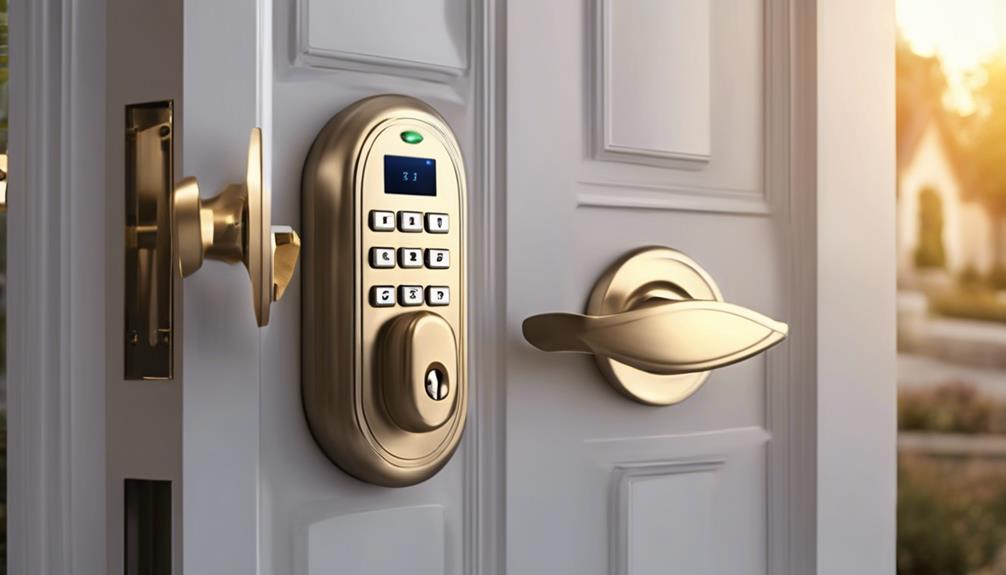
Ultimately, understanding the diverse functionalities and potential limitations of electronic locks empowers homeowners to enhance their security with confidence and modern convenience. I remember the peace of mind I felt integrating a smart lock with my home system, knowing I could monitor and control access remotely. Keypad, smart technology, or biometric features offer tailored solutions for various security needs. However, it’s important to remember that these advanced systems require power sources or regular battery changes. Biometric locks, with their unique fingerprint recognition, provide an unmatched level of security. By weighing these features and limitations, homeowners can make informed decisions, ensuring their homes remain secure yet accessible, blending technology seamlessly with everyday life.
Frequently Asked Questions
How Do Electronic Locks Perform in Extreme Weather Conditions?
Electronic locks excel in extreme weather conditions, thanks to their robust construction with weather-resistant materials like stainless steel and durable plastics. I recall installing one with a high IP rating on my cabin; it withstood a harsh winter and a sweltering summer without a hitch. Waterproof seals and coatings effectively shield internal components, making them reliable choices for outdoor installations. Choose wisely, and these locks won’t let you down.
Can Electronic Locks Be Hacked or Tampered With Easily?
Electronic locks, while convenient and advanced, can indeed be susceptible to hacking if not properly secured. Vulnerabilities such as brute force attacks, key duplication, or signal interception pose risks. Manufacturers aim to enhance security, but users must remain vigilant by updating software, using encryption, and adopting multi-factor authentication. Biometric locks offer higher security, yet still require diligence. Regularly changing access codes further fortifies protection against potential threats.
Are Electronic Locks Compatible With Existing Home Security Systems?
Yes, electronic locks can indeed be compatible with existing home security systems, allowing for seamless integration and centralized control. This compatibility enhances overall home protection by providing real-time alerts and activity logs for all entry points. However, it’s important to verify the compatibility between the specific brands and models of the electronic lock and the home security system before making a purchase to guarantee ideal functionality.
What Are the Power Backup Options for Electronic Locks During Outages?
For those concerned about power outages, electronic locks offer various backup options. Many incorporate battery packs, guaranteeing continued operation. Some models feature manual key overrides for added security. Additionally, innovative smart locks harness solar or kinetic energy. Rechargeable or replaceable batteries also provide reliable alternatives. Regular maintenance, like checking and replacing these power sources, is essential to secure your lock’s continuous functionality, even during unexpected outages.
How Often Should the Batteries in Electronic Locks Be Replaced?
Imagine a steadfast guardian who tirelessly watches over your home, yet requires periodic nourishment. The batteries in electronic locks, akin to this guardian’s sustenance, should be replaced every 6-12 months. Based on my experience, high-quality alkaline batteries guarantee top performance. Regularly checking the low battery indicators and replacing them timely is essential to avoid lockouts and maintain security. Neglecting this can compromise your safety and convenience.

